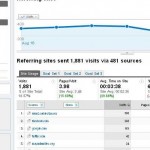A digital magazine can be downloaded to your Adobe Reader, rather than mailed to your home. Digital magazines simulate the act of “turning pages” by clicking an arrow. It appears as if you are looking at a Xeroxed magazine through one of those old-school newspaper-viewers they had before computers. You know the ones where you turn the dial and you see a microfiche of the next page?
Of course the quality is a lot nicer now.
There are several ways that you can make money using this business model. You need content, SEO, and analytics in order to get advertisers. It is a bit more complex, but these are the basics. The need for good content is a given, so I will concentrate on the other two areas.
Analytics for Digital Magazine & Content Sites
The primary issue is that your readers are consuming content in two completely different areas: the Adobe Reader Magazine and on the web. Some people will prefer one or the other, some both. You will probably have to reconcile this data for your advertisers.
Or just lose the magazine and go with only web content.
Assuming you must keep the magazine, here are the ways to monetize the content:
a) Adsense/ Doubleclick type ads (“non-guaranteed inventory”)
b) Direct advertiser purchases (“guaranteed inventory”)
c) Affiliate links
d) Paid Subscriptions
e) Selling users’ personal information or using it in some way.
A. To make money with this type of content you need good content (obviously), a lot of pages, and visible ads (because we want people to click on advertisers ads). Advertisers care about getting converting traffic to their traffic. If you don’t provide it, they will stop advertising on your domain.
The advantage of adsense is that you can set it and leave it and the inventory will be filled. The disadvantages are that you can’t place adsense on adobe pages and you have little control over your advertisers.
B. There are two types of ad purchases: An ad in the digital magazine and an ad on the site. Getting companies to buy inventory on the site will be relatively easy. Just provide them stats. Getting them to buy space in the digital magazine will be much more difficult. Obviously it may just involve getting a salesman to talk an advertiser into giving you money. More likely it will involve a complex analysis in which you show how many of your website readers subscribe/download the magazine, and what do you know about those users. You can use analytics for this. IF you have everything set up properly it still will take time (to accumulate historical data) and a great analyst to figure out how to “spin” the data into actual business drivers.
C. Affiliate links are relatively easy to set up. You sign up and then embed links in your content. If someone clicks and then goes and makes a purchase you get a percentage. The risk is that you will alienate your readers if you do it poorly or too often, or you will send readers off your site and they will not purchase.
D. If you can get people to pay you directly for your content- that is great. Signing up for an RSS feed is ok too.
E. If you have people’s info, you can sell them stuff. There is a line between re-marketing and creepy that could hurt your brand.
I would assume that most companies use a combination of all of these methods. The problem is that some of these can be labor intensive (C), require incredible talent (A, B, C), and require tough decisions from upper management regarding how to allocate limited resources. In each case, intelligent business decisions will lead to larger advertisers, so analytics plays a huge role in the content business. Also, content sites tend to be the largest.
Acquiring Readers with SEO, Paid search, and Social
You need readers in order to have a business. Good content is important, but it needs to be optimized for SEO so that the engines will pick up your content. Good SEO takes a long time, and gains are incremental. At times SEO can conflict with content and design, so you must have a strong decision-maker at the top who is responsible for SEO/Content/Design conflicts.
There are some cases it may be worthwhile to purchase readers (e.g. advertise) so that visitors to your website buy from your advertisers (hopefully for more than you paid to acquire them). This is called arbitrage; this practice is looked upon unfavorably by some companies, and can get you permanently banned, so be careful how you use it.
Social media is a great way to get a loyal readership going. I would look to involve an intern in this process. It would be a good introduction into the world of internet marketing.

